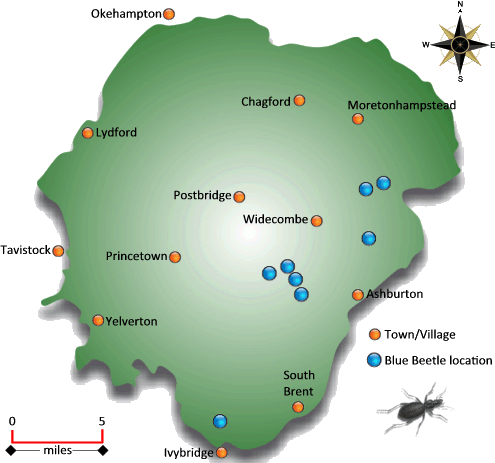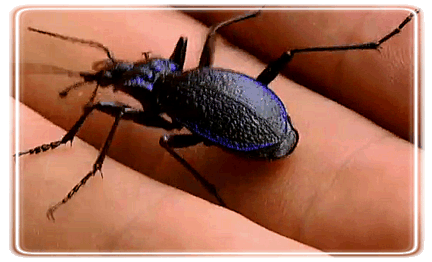
Having just watched the Dartmoor programme of Ray Mears’ ‘Wilderness Walks’ where he went in search of the rare Blue Ground Beetle (Carabus intricatus) I thought as it’s a ‘legend’ it had better have it’s own page. Why is it a Dartmoor ‘legend’? Primarily because it is Britain’s largest native Carabid and also that it is only found at a handful of sites in the United Kingdom, Dartmoor having the largest number of these. There are varying estimates as to how many locations are home to the beetle but suffice it to say there are but a handful. Such is its rarity that in 2010 the Joint Nature Conservation Committee classified the beetle as being under ‘International Threat’ and as far as the UK goes only being found in England. In 2001 the Blue Ground Beetle was listed in the Dartmoor Biodiversity Action Plan as being a key species. In 2007 action plan was as follows:
|
Actions for Blue Ground Beetles on Dartmoor |
|
| Site Safeguard | Safeguard sites against direct threats through planning controls & other consultation procedures |
| Seek to establish management agreements or other conservation management over all sites | |
| Habitat Management | Ensure all sites are appropriately managed with minimal intervention and light grazing through assessments made every 5 years. |
| Seek changes in management where necessary. | |
| Research & Monitoring | Undertake monitoring of all 5 sites every 5 years to assess habitat suitability and beetle presence. |
| Encourage further research into the ecology of the species eg. larval requirements, movement of adults, oviposition, diet, etc. | |
| Communication & Publicity | Write at least one article every 3 years to promote ancient woodland invertebrates and Blue Ground Beetles |
|
Blue Ground Beetle Key Conservation Objectives and Targets |
|
|
Secure the long term future of the Blue Ground Beetle on Dartmoor Objectives & Targets |
|
| Objective 1 | Maintain at least three sites known in 1999 |
| Complete an assessment of the distribution of Blue Ground Beetles on Dartmoor by 2001 | |
| Maintain populations at the 5 sites known in 2006 | |
|
Achieve a better understanding of the requirements of Blue Ground Beetles on Dartmoor |
|
| Objective 2 | Encourage further research into the ecology of the Blue Ground Beetle |
| Establish the habitat requirements of the Blue Ground Beetle by 2001 | |
| Establish the best methods fro survey & monitoring Blue Ground Beetle by 2001 | |
| Objective 3 | Use Blue Ground Beetle to raise awareness of the value and importance of ancient oak woodland on Dartmoor for invertebrates. |
| Produce at least one article on the Blue Ground Beetle annually in the Dartmoor Biodiversity Newsletter or other media until 2006, thereafter at least one article every 3 years. |
In a review of 2011 it was considered that although vulnerable the population was stable which is good news all around. Below is a map showing the distribution of Blue Ground Beetles on Dartmoor. In 2002 there were reports in the Devonshire County Records of the beetle living in; Dendles Wood, Houndtor Wood, Aish Tor, the Bovey Valley and the Dart Valley, All in all these recordings totalled 56 beetles, Henwood, p.358.

Adapted from Dartmoor Species Action Plan for Blue Ground Beetle – 2007 (online source)
The elusive Blue Ground Beetle was first seen in Britain in 1811. at of all places it the Virtuous Lady mine near Tavistock where it made its debut. The finder was Dr. Leach who then presented it to the British Museum, Dawson, pp. 34 – 35. It then went walkabouts for many years and was thought to have been extinct. At this time such was the concern as to the beetle’s demise that a handsome reward of £5 was offered to anybody finding one. In 1826 the Carrington Brothers listed the Blue Ground Beetle as one that was ‘inhabiting in the vicinity of Dartmoor, p.154.
It was not until 1856 that the next one was found on the edge of Dartmoor but this was not in the best of health and only £3.10 shillings was paid to the finder due to it being badly damaged, John Walters – online source.
So having established that the Blue Ground Beetle is one of Dartmoor’s rarities what about the beetle itself. As mentioned above the Blue Ground Beetle is Britain’s largest ground beetle and can grow between 24 -35mm in length. They have a rough, metallic blue elytra or protective wing case which in the case of this beetle is not a lot of use because it can’t fly. In the daytime they can be found at the base of trees living in the mossy clumps or in dead wood. It is at nigh time when they become active and venture out in search of their prey which out of preference is the tree slug or Limax marginatus. When searching for these slugs they first find a slug’s slime trail and the follow it until it’s located. Then with the aid of their large pincer-like jaws they seize it and inject the body with digestive juices. These then begin to dissolve the slug’s body which the beetle then sucks up, it is said that the whole process of devouring the slug only takes about half an hour.
Nature has provided the Blue Ground Beetle with a rather viscous defence mechanism insomuch as when threatened by a predator (or human come to that) it can squirt a jet of acid from its abdomen.

The adults mate and lay eggs in the Springtime after which the larvae develop through the summer and with their black and shiny appearance look like a miniature Darth Vader, they emerge as adults in the Autumn. Their preferred habitat is that of ancient oak or beech woodlands usually on south facing slopes of river valleys. These woodlands need to be densely moss-covered with high humidity and lightly grazed by animals.
William Crossing published a book call ‘Gems in a Granite Setting’ which was about the many magical places of Dartmoor. So taking his lead maybe this page should have been called ‘Gems in a Mossy Settings’ for that is what these iridescent beetles surely are.

Carrington, N. T. & Carrington, N. T. 1826. Dartmoor – A Descriptive Poem. London: Hatchard & Son
Dartmoor National Park Authority. 2007 Dartmoor Species Action Plan for Blue Ground Beetle -Online source – HERE
Dawson, J. F. 1854. A Monograph of the Carnivorous Ground Beetles Indigenous to the British Isles. London: J. V. Voorst
Henwood, B. 2003. 55th Report of the Entomology Section – Transactions of the Devonshire Association – Vol.135.
Walters, J. 2014 Blue Ground Beetle – Online source – HERE
 Legendary Dartmoor The many aspects past and present of Dartmoor
Legendary Dartmoor The many aspects past and present of Dartmoor

Blue ground beetle discovered at the edge of the main path through the Teign Valley – right hand side heading towards Fingle Bridge about a mile beyond the suspension bridge. Sadly no camera so no proof – perhaps you know who to inform?
You can report the sighting to The National Biodiversity Network at this ip addreess – https://nbn.org.uk/
Hi Tim ,today I was lucky enough to encounter the most amazing beetle I’ve ever seen,on researching the picture and size I discovered it was a blue ground beetle also with the research I see it was a protected species ,so I’m extremely worried as Taylor wimpey are trying to build on the land ,can you help in anyway.
The location is ivybridge
Yours sincerely Richard